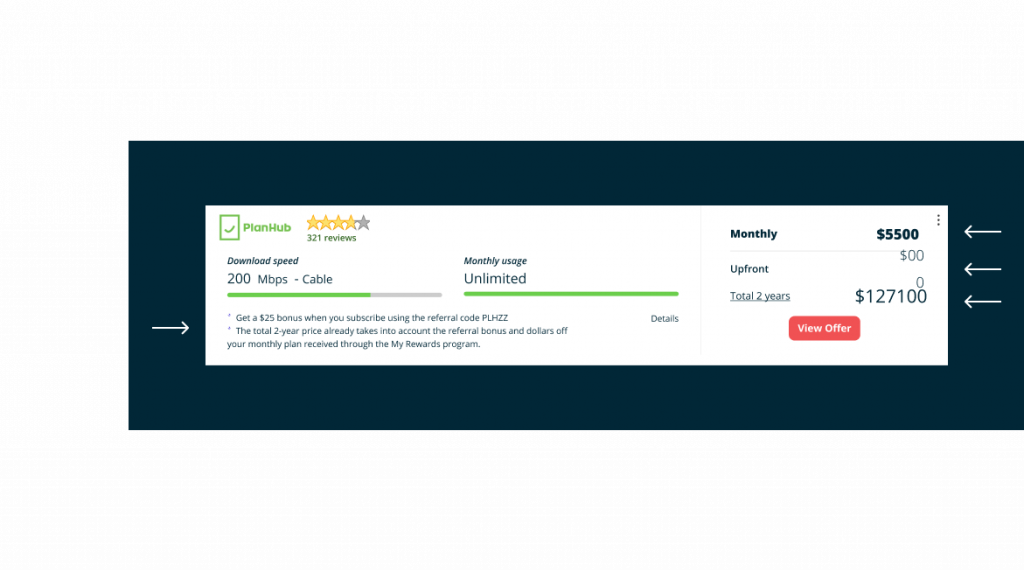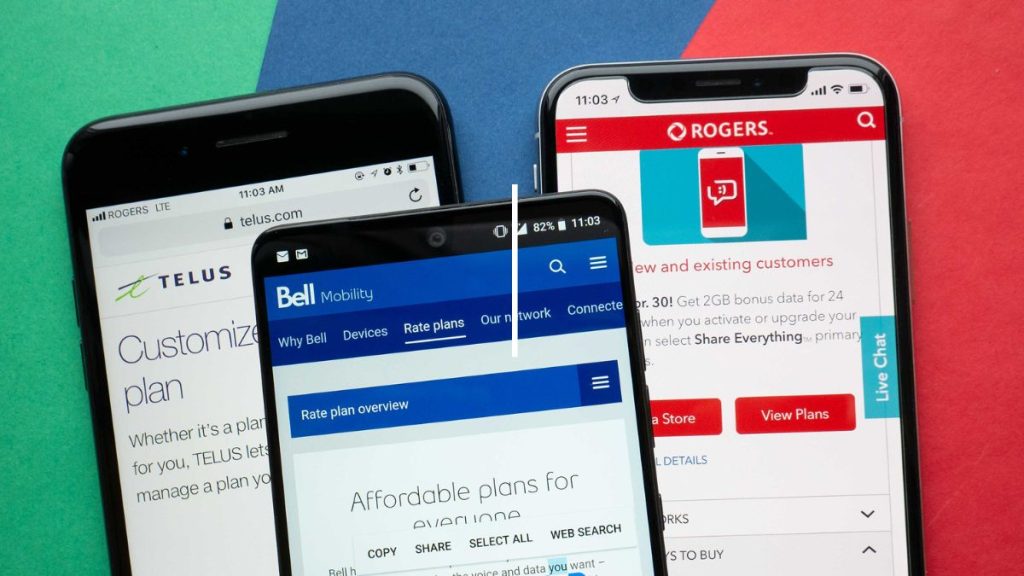Step 1: Determine your household needs
Step 2: Determine your budget
Step 3: Determine the provider and technology options for your home address
Step 4: Understand the plans offered
Step 5: Choosing your Internet plan
Step 6: Find ways to save money and even take advantage of it
Step 7: Once you’ve purchased a plan, stay alert!
Choosing an Internet plan in Canada requires considering the particularities of our geography. As the second largest country in the world in terms of surface area, the operators offers differ greatly depending on the regions and the population density. As far as technologies are concerned, you have the choice between cable, fibre and satellite.
The change in habits brought by telecommuting is a new factor to consider. Gone are the days when 50 Megabytes was enough for the family, especially since the arrival of 4K and the multiplication of communication means, working from home also requires a review of your subscription.
Choosing your Internet plan in Canada will depend on a few factors to consider before signing an agreement with your future provider.
Step 1: Determine your household needs 
Which Internet speed to choose?
A dozen dollars often separates a subscription from a superior plan that offers double the speed. However, depending on the number of people in your household and their habits, this can change everything. Other than streaming services like Netflix, Prime Video and YouTube, online video games have replaced television and also require their share of bandwidth, as does streaming on platforms like Twitch.
Is unlimited Internet the best option?
Listening to online videos consumes about 6 to 8 GB of data per hour, while video games require about 300 MB per hour. At this rate, it’s easy to exceed the 100 GB limit included in basic plans.
It’s better to opt for an unlimited subscription, especially since the extra cost is ridiculous. For example, at Bell, the difference is $5 per month ($55 versus $60) between the basic Internet subscription and Fibe 50, which also offers five times the speed and unlimited downloads.
Good to know if you don’t use the Internet much, but want to watch TV, the consumption requested for the TV is not counted in your consumption. This formula applies of course when using the receiver of your provider. If you use the applications on your TV set, your data will be counted.
Remote work: what is the right connection speed?
While telecommuting saves you time on your commute, it is mostly dependent on the stability and power of your connection. When choosing your provider, those who telecommute will also need to consider these few parameters.
How many people use your connection when you work?
If your family is present in the home during your office hours, then their internet usage can put a strain on your bandwidth. While you can always demand that your kids cut off their connection for trivia, it’s hard to demand that they cut off an online court. You’ll need to calculate your usage and choose an internet subscription with a speed that can cover your family’s needs.
What download speed do you need?
Whether you’re working on text or a 3D artist, the demand for bandwidth is not the same, and your choice of which plan to choose will depend on your work. If you send and receive Word or Excel documents of a few tens of Kb and attend meetings, your connection speed will have to be at least 50 Mbps for a person living alone and 100 to 200 Mbps at least for a family.
If you have to handle files of several GB, you’d better bet on a connection of at least 400 Mbps.
What upload speed should I choose?
Here again, the choice of your plan will depend on your activity. If your work requires you to send only text files and to participate in meetings, 10 Mbps is sufficient.
If you handle files of several gigs of data that you need to send to remote servers, you’re better off with an uplink connection of at least 50 Mbps.
We realize that 10 Mbps doesn’t sound like much, but here’s the data provided by Microsoft regarding the data upload per hour during video calls on Microsoft Teams depending on the quality of your webcam:
● 225 MB of data Quality of 360p video call at 30 fps
● 540 MB of data for HD quality video calls with HD 720p resolution at 30 fps
● 675 MB of data for HD quality video calls at HD 1080p resolution at 30 fps
● 225 MB of data for group video calls
● 450 MB of data for 540p 1080p HD display group video calls
Bandwidth reseller providers, is it worth it?
Alternative operators do not use their own lines, but those of incumbent operators who have the financial means to install their own network. However, using another operator’s network does not mean cheap speed. Whether you opt for fibre or cable, you get the same performance from an alternative operator as users who subscribe to the incumbent operator who operates it.
If you’re less concerned about the speed of the service or if an average speed of 200 Mbps is enough for you, these providers can offer you some savings.
For video games, is ping as important as speed?
If you play online video games, ping is of paramount importance. It represents the time between a signal from your game machine and its reception by the remote server. When you make a move against an online opponent, the action and your position are sent to the remote server. The shorter the time, the more your action is reflected without any feeling of lag.
If you are playing online, it is important to choose a provider with a ping of fewer than 10 milliseconds.
Self-employed and small companies, be careful with your consumption!
If you telework or decide to set up your business at home, but subscribe to a residential subscription, operators impose a limit of 3 TB of data per week. If you regularly exceed this limit, they may be likely to call you and terminate your contract. If you are a self-employed entrepreneur and will be using a lot of data, it would be best to subscribe to a professional subscription with your ISP.
How to choose your internet speed?
If choosing your speed requires taking into account several parameters, PlanHub offers a simple method to determine the speed that will suit you best, simply answer the PlanHub questionnaire and choose the option “I don’t know, help me choose” when choosing the speed. We will then be able to provide you with an estimate of the speed that best suits your needs and the people living under your roof.
To determine the internet speed you need, ask yourself the following questions:
- How many people are telecommuting from your home?
- Will you be downloading or needing to send large files (several GB)
- Will the connection be used to watch streaming videos?
- Will the connection be used to play online video games or stream content such as Twitch?
- How many devices will be connected to your network?
Step 2: Determine your budget 
How much money should you spend on your internet connection?
PlanHub estimates that no more than 1% of your gross household income should be spent on your internet plan. For two people with a combined gross annual income of $100,000, $83 should be spent on their monthly bill. This estimate was obtained by following the many budgeting guides of 2023.
However, several factors can influence this figure, starting with your telecommuting needs and whether you have multiple smart devices turned on and connected. In this case, it’s best to plan for a higher speed.
Please consult a professional in the field to validate if this budget applies to your family situation.
Am I paying too much for my current connection?
PlanHub’s Internet speed test is the perfect tool to find out what the competition is charging and to evaluate the right price for your Internet subscription. After testing your connection speed, the tool will show you the best plans available for speeds similar to yours. You’ll be able to judge and compare your subscription with the options available to you and find out if you’re paying too much for your Internet plan.
Step 3: Determine the provider and technology options for your home address
 How do I know which Internet provider offers the best speed locally?
How do I know which Internet provider offers the best speed locally?
PlanHub’s internet plan finder allows you to determine at a glance what speeds are offered by different providers at the local level. To do so, enter your postal code at the end of the questionnaire to define your internet needs. The options that will be proposed to you will of course take into account the technologies available at your residential address.
How to avoid paying extra on your internet plan?
Current modems are limited to four Ethernet ports (RJ 45). Access providers can offer you splitters that allow you to add lines, but depending on the price proposed, it is better to look at what is available on the market. For example, a TP-Link WiFi booster costs only $22. Your operator will ask you for a few dozen dollars to increase the number of Ethernet ports and will tell you about approved and compatible products. Except that commercially available products work just as well and are fully compatible. Just be sure to store around for a box that can handle connections over 1 Gbps if you’re connected to fibre.
The optional antivirus solutions offered by your provider are effective, but so is the antivirus on your computer. If you are on a PC, Microsoft provides Windows Defender free of charge, which is recognized as an excellent antivirus solution that is as effective as the best paid solutions on the market. On the Mac, its low market share protects it from attacks, just like Linux.
What technologies are available in Canada?
Fibre, cable or satellite? These three technologies coexist in Canada, each with its own advantages.
Is fibre optic the fastest?
Fibre optic internet is currently the technology that allows the highest speed in downloading and uploading. Inside the cables, data is transmitted via light. This results in a considerable increase in speed to the point where we have not yet reached the limit of fibre, even in the laboratory.
In Canada, fibre is now widely available in major cities and is beginning to reach the regions.
Cable, the best value for money?
In 2023, cable internet is definitely one of the best, if not the best value option. Cable internet uses the copper wires contained in the cable to transmit data. Currently, the limit of data transfer via cable is 1000 Mbps in Canada. However, cable has not said its last word since the next generation of cable networks will be able to reach 10 Gbps.
Is satellite internet a Starlink revolution?
Satellite internet has long been a backup solution in remote locations where operators do not offer speeds higher than 5 Mbps. However, the rates are expensive and the speed is penalized by a latency of 600 milliseconds.
Starlink’s offer is therefore unique at the moment since it allows speeds of up to 200 Mbps with a latency of 20 milliseconds. However, this offer is worth considering if you live in an area with lower internet speeds than Starlink’s offer.
Step 4: Understand the plans offered
What to understand about an internet plan to make the right choice?
When you compare plans from different internet providers on PlanHub, here’s how to understand what’s being offered.
The amount ” Monthly ” indicates the amount you will have to pay each month for your plan.
The amount to the right of “Initial” indicates what you will have to pay when you sign up for your plan. This usually includes the activation fee and the cost of a new modem, if applicable.
The “Total 2 years” is the sum of what your subscription will cost you at the end of the 24 months before taxes.
Read the additional notes carefully! They can tell you about additional discounts, temporary promotions, cashback and other rewards specific to the plan you have selected.
Can I install my modem myself or do I have to choose the installation option?
If you choose a new service provider, their line may not have been previously pulled to your home. In this case, you will be required to use the installation option offered by your provider, but there is a fee.
If you already have a line, a manual installation is possible, but be careful! Installation manuals are not always clear and the steps described do not always correspond to reality. The best thing to do in this case is to keep your phone close by and contact your provider’s customer service department, which will guide you step by step.
Step 5: Choose your Internet plan
How to choose the right residential Internet plan?
Now that you have determined the main elements: your needs, your budget, which operators cover your geographical area, and that you have understood the proposed plans, you will be able to make the right choice and choose the Internet plan that best suits your needs.
Planhub’s tool will automatically facilitate your task and direct you to the plans best suited to your situation. Don’t hesitate to compare different internet plans and offers.
Depending on your financial situation, you will choose a plan that is economical or one that gives you peace of mind. Make sure that the subscription you choose meets your needs and respects your ability to pay.
Step 6: Find ways to save money
Why bundle your services?
If you already have a subscription for your cell phone or for your family, it may be a good idea to subscribe to the same Internet service provider. You will automatically receive a discount on your services. Some providers are also more likely to give you new subscriber rates or special offers when you renew your subscription if you already subscribe to many services with them.
How to avoid the activation fee?
When you move, sign up with a new provider or even change your internet service while staying with the same provider, a $50 fee may be required to activate your line.
You can get rid of this fee by making some common sense arguments. Point out that you are committing yourself for two years, for example, or that despite your move you remain a loyal customer, and if you add a service, make this argument as well.
Activating a line takes less than 5 minutes in real life, and the longer you stay with your provider, the more money they make from your subscription. Providers are therefore generally willing to give you the gift of activation, especially if you show them that you are a good customer and are likely to stay if the service offered is up to your expectations.
How do you manage the cost of the material?
Be sure to check with the agent on the phone to see if the equipment is loaned or rented to you. If it is leased, it may be more cost-effective to purchase it outright. Calculate the monthly payments for your subscription period, and if the total amount is more expensive than the purchase of the modem, buy it and you will save money.
Good to know, some operators may require the sale of their modem that you pay for at the same time as your subscription, as in the case of Videotron. Generally, you can take advantage of a preferential rate in exchange for a two-year commitment, but the cancellation fees are about $300.
Step 7: Once you’ve purchased a plan, stay alert!
What are the options to avoid late payment fees?
Late payment fees can increase and accumulate even if you have a late payment and continue to pay your bills, for example, if you forget. To avoid this situation, make sure you choose a plan that fits your budget, and also watch your emails so that you pay when you receive your electronic bill. The best thing to do is to use an automatic payment method to make sure that you are debited on time and that you do not have to pay any fees.
What to do if your internet provider presents new and more advantageous offers?
It can happen that a subscription more advantageous than yours appears. In this case, contact the customer service of your provider, and switch to a new plan by committing yourself to one to two years. The providers’ interest is to keep you, and if one of their new plans suits you even better, they will be happy to keep you as a customer, and might even agree to the reduction on your subscription without changing the plan if you are convincing enough!












